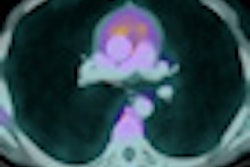
NEW YORK (Reuters Health), Feb 11 - Squamous cell carcinoma of the head and neck can be staged more accurately with whole-body PET using F-18 FDG, according to European researchers.
In the February 1 online issue of the Journal of Clinical Oncology, the investigators report that in their study, adding PET-FDG to staging in newly diagnosed patients improved accuracy in 20% of cases and altered management in 13.7%.
According to lead author Dr. Max Lonneux of the Cliniques Universitaires Saint-Luc, Brussels, this prospective study, with 233 patients, is the largest so far on PET-FDG for initial staging of such cancers.
"PET is cost-effective in many oncological situations," he noted in e-mail to Reuters Health. "By increasing the accuracy of pretherapeutic staging, PET allows for a better selection of the appropriate therapeutic regimen for a particular patient."
Dr. Lonneux pointed out that PET-FDG is already "a standard of care for the management of non-small cell lung cancer, lymphoma, recurrent colorectal cancer, and melanoma."
The average age of patients in the study was 60 years; 78% were men. All had conventional screening tests, including fibroscopic and direct endoscopic examinations with biopsy, CT, or MRI of the head/neck region, and CT of the thorax. Each patient was staged based on this information. Then, after whole-body PET-FDG scan, they were staged again.
In 100 patients, the two staging assignments were discordant. In 40 of these cases, the discrepancies were not investigated because the treating physician did not expect that treatment would change based on new information.
Among the remaining 60 patients with discordant findings, PET-FDG was accurate in 47 cases, leading 30 to be upstaged and 17 to be downstaged. Therapeutic plans for 32 patients (13.7% of 233) were altered on the basis of PET-FDG results.
According to the researchers, the factor with the greatest effect on patient management was confirmation or exclusion of metastatic or additional disease. In six patients, this finding shifted the approach from curative to palliative. In nine others, PET-FDG ruled out metastatic disease, qualifying those patients for curative-intent therapies.
The researchers conclude, "Our results support the implementation of PET-FDG imaging in the routine imaging work-up of head and neck squamous cell carcinoma."
By Scott Baltic
J Clin Oncol 2010.
Last Updated: 2010-02-10 18:17:07 -0400 (Reuters Health)
Related Reading
Early FDG-PET/CT may help head and neck cancer therapy, November 20, 2009
FDG-PET/CT scans spot head and neck cancer return October 14, 2009
FDG-PET/CT reveals occult metastasis of head and neck cancer, September 7, 2007
Copyright © 2010 Reuters Limited. All rights reserved. Republication or redistribution of Reuters content, including by framing or similar means, is expressly prohibited without the prior written consent of Reuters. Reuters shall not be liable for any errors or delays in the content, or for any actions taken in reliance thereon. Reuters and the Reuters sphere logo are registered trademarks and trademarks of the Reuters group of companies around the world.


















